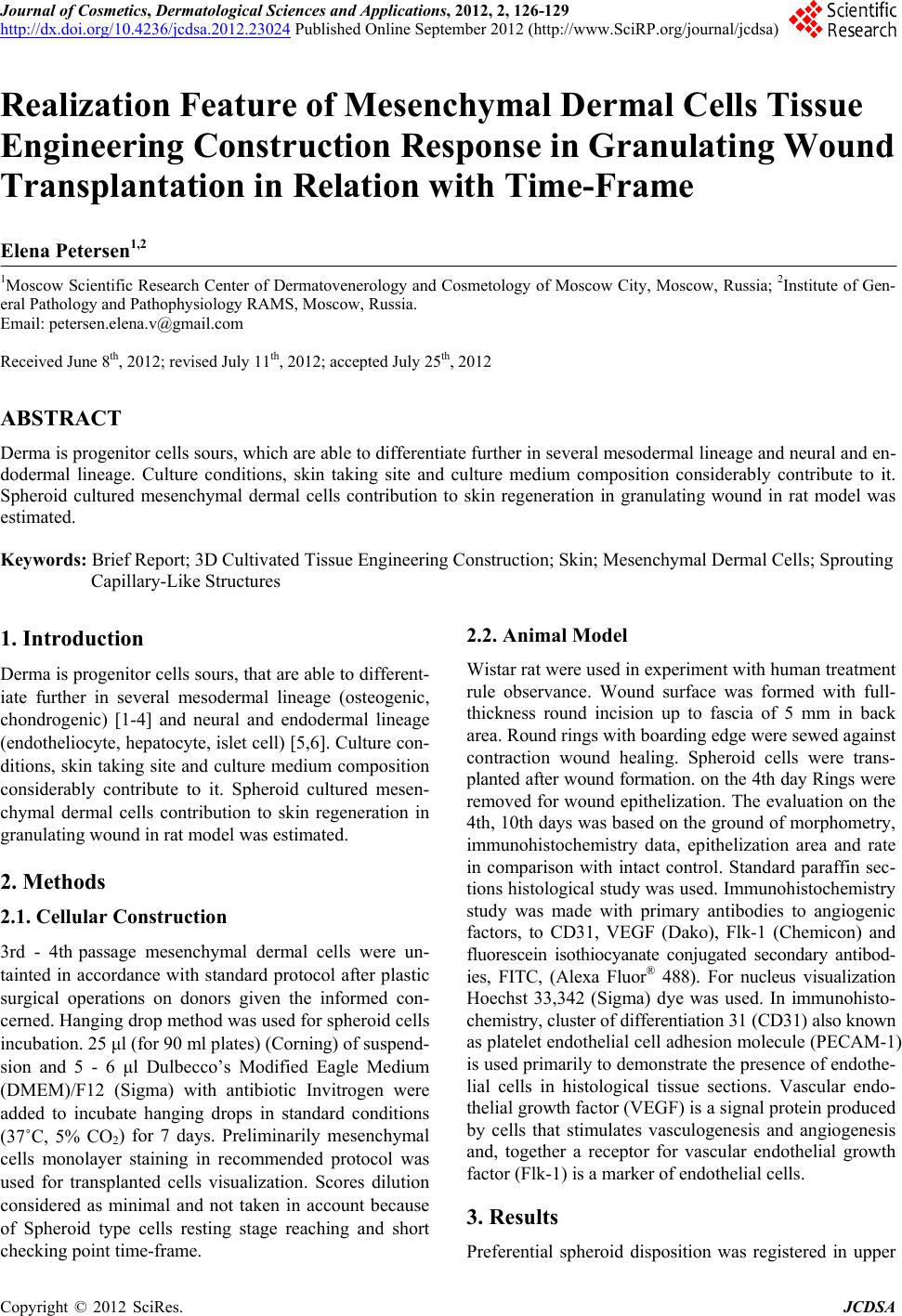
Journal of Cosmetics, Dermatological Sciences and Applications, 2012, 2, 126-129
http://dx.doi.org/10.4236/jcdsa.2012.23024 Published Online September 2012 (http://www.SciRP.org/journal/jcdsa)
Realization Feature of Mesenchymal Dermal Cells Tissue
Engineering Construction Response in Granulating Wound
Transplantation in Relation with Time-Frame
Elena Petersen1,2
1Moscow Scientific Research Center of Dermatovenerology and Cosmetology of Moscow City, Moscow, Russia; 2Institute of Gen-
eral Pathology and Pathophysiology RAMS, Moscow, Russia.
Email: petersen.elena.v@gmail.com
Received June 8th, 2012; revised July 11th, 2012; accepted July 25th, 2012
ABSTRACT
Derma is progenitor cells sours, which are able to differentiate further in several mesodermal lineage and neural and en-
dodermal lineage. Culture conditions, skin taking site and culture medium composition considerably contribute to it.
Spheroid cultured mesenchymal dermal cells contribution to skin regeneration in granulating wound in rat model was
estimated.
Keywords: Brief Report; 3D Cultivated Tissue Engineering Construction; Skin; Mesenchymal Dermal Cells; Sprouting
Capillary-Like Structures
1. Introduction
Derma is progenitor cells sours, that are able to different-
iate further in several mesodermal lineage (osteogenic,
chondrogenic) [1-4] and neural and endodermal lineage
(endotheliocyte, hepatocyte, islet cell) [5,6]. Culture con-
ditions, skin taking site and culture medium composition
considerably contribute to it. Spheroid cultured mesen-
chymal dermal cells contribution to skin regeneration in
granulating wound in rat model was estimated.
2. Methods
2.1. Cellular Construction
3rd - 4th passage mesenchymal dermal cells were un-
tainted in accordance with standard protocol after plastic
surgical operations on donors given the informed con-
cerned. Hanging drop method was used for spheroid cells
incubation. 25 μl (for 90 ml plates) (Corning) of suspend-
sion and 5 - 6 μl Dulbecco’s Modified Eagle Medium
(DМЕМ)/F12 (Sigma) with antibiotic Invitrogen were
added to incubate hanging drops in standard conditions
(37˚C, 5% СО2) for 7 days. Preliminarily mesenchymal
cells monolayer staining in recommended protocol was
used for transplanted cells visualization. Scores dilution
considered as minimal and not taken in account because
of Spheroid type cells resting stage reaching and short
checking point time-frame.
2.2. Animal Model
Wistar rat were used in experiment with human treatment
rule observance. Wound surface was formed with full-
thickness round incision up to fascia of 5 mm in back
area. Round rings with boarding edge were sewed against
contraction wound healing. Spheroid cells were trans-
planted after wound formation. on the 4th day Rings were
removed for wound epithelization. The evaluation on the
4th, 10th days was based on the ground of morphometry,
immunohistochemistry data, epithelization area and rate
in comparison with intact control. Standard paraffin sec-
tions histological study was used. Immunohistochemistry
study was made with primary antibodies to angiogenic
factors, to CD31, VEGF (Dako), Flk-1 (Chemicon) and
fluorescein isothiocyanate conjugated secondary antibod-
ies, FITC, (Alexa Fluor® 488). For nucleus visualization
Hoechst 33,342 (Sigma) dye was used. In immunohisto-
chemistry, cluster of differentiation 31 (CD31) also known
as platelet endothelial cell adhesion molecule (PECAM-1)
is used primarily to demonstrate the presence of endothe-
lial cells in histological tissue sections. Vascular endo-
thelial growth factor (VEGF) is a signal protein produced
by cells that stimulates vasculogenesis and angiogenesis
and, together a receptor for vascular endothelial growth
factor (Flk-1) is a marker of endothelial cells.
3. Results
Preferential spheroid disposition was registered in upper
Copyright © 2012 SciRes. JCDSA